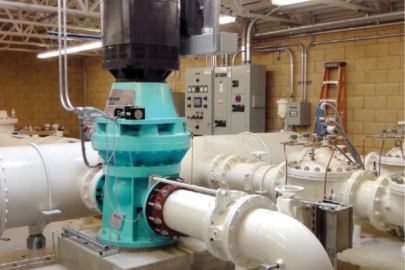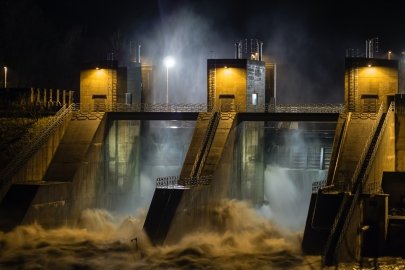Through the New Technologies and Advanced Manufacturing portfolio, part of the Hydropower Program in the U.S. Department of Energy’s Water Power Technologies Office (WPTO), researchers develop new cost-effective technologies that leverage advanced manufacturing and materials while incorporating ecological and social objectives. Part of the Innovations for Low-Impact Hydropower Activity Area, this portfolio aims to advance technologies for new stream-reaches, non-powered dams (NPDs), and conduits, while using advanced manufacturing techniques to maximize their efficiency.
This work focuses on the following research priorities:
Only 3% of the nation’s roughly 90,000 dams are currently equipped with electricity-generating equipment. Existing NPDs can be retrofitted for hydropower generation without the costs and impacts of additional dam construction. WPTO seeks to:
- Classify NPDs: Perform a study to classify existing U.S. NPDs based on key attributes relevant for hydropower development and integrate those findings into a user-friendly geospatial tool.
- Develop new technologies for powering NPDs: Informed by the classification study, develop design guidelines incorporating lessons learned about standardization and modularity, and support development of new technologies and construction methods to cost-effectively power NPDs.
- Test new technologies for powering NPDs: Evaluate the performance of new technologies and methods for NPDs at a partial and/or full scale.
Conduit hydropower projects can be developed on existing water-conveyance structures, such as irrigation canals or pressurized pipelines that deliver water to municipalities, industry, or agricultural water users. There are many thousands of miles of existing conduits in the United States that transport water. WPTO seeks to:
- Assess hydropower resource potential at existing conduits: Identify existing U.S. water conveyance systems and quantify available hydropower resource potential.
- Develop new hydropower technologies for conduit applications: Develop technologies and methods to cost-effectively add hydropower to existing conduits and canals.
- Test new technologies for conduit applications: Evaluate the performance of developed technologies for conduits and canals at a partial and/or full scale.
- Demonstrate new conduit technologies: Conduct a field demonstration to validate new technologies at an existing conduit or canal.
Over the last decade, advanced manufacturing has revolutionized many parts of the energy sector, providing several benefits over conventional manufacturing techniques, such as enhanced design flexibility, decreased energy consumption, lower costs, and reduced time to market. WPTO seeks to:
- Identify high-impact advanced manufacturing opportunities: Utilize creative funding mechanisms to identify advanced manufacturing opportunities for hydropower applications.
- Incorporate advanced manufacturing into designs: Incorporate advanced manufacturing and materials with the potential to reduce costs or increase performance into the design of hydropower components.
- Test new advanced manufacturing technologies: Evaluate the performance of new advanced manufacturing technologies and methods at a partial and/or full scale.
- Demonstrate new advanced manufacturing technologies: Conduct a field demonstration to validate new advanced manufacturing technologies and methods in a real-world site.
New stream-reach development refers to new hydropower development in stream-reaches that do not currently have water infrastructure. Exploring hydropower capabilities in these untapped areas can result in new projects that generate renewable energy while preserving and, in some cases, enhancing stream functionality. WPTO seeks to:
- Quantify benefits of standardization and modularity: Perform studies into past investments to quantify the potential benefits—such as increased environmental compatibility, lower costs, and shorter construction times—of standardization and modularity for new hydropower development.
- Design new standard modular technologies: Use the results of techno-economic studies to revise design guidelines and support development of new standard modular technologies.
- Test new standard modular technologies: Evaluate the performance of new standard modular technologies at a partial and/or full scale.
Featured Products and Publications
-
 Natel Energy’s Restoration Hydro Turbine is the first in the industry to enable safe passage for large and small fish while also meeting installation configurations for a wide variety of hydropower facilities.
Natel Energy’s Restoration Hydro Turbine is the first in the industry to enable safe passage for large and small fish while also meeting installation configurations for a wide variety of hydropower facilities. -
Researchers created and tested a composite hydropower turbine runner blade and found it performed nearly identically to traditional blades made of stainless steel.
-
 An Oak Ridge National Laboratory report found opportunities to develop hydropower on conduits in every state, totaling 1.41 gigawatts of new generating potential.
An Oak Ridge National Laboratory report found opportunities to develop hydropower on conduits in every state, totaling 1.41 gigawatts of new generating potential. -
 Oak Ridge National Laboratory developed two tools and published a report to aid developers making decisions about whether to add power-generating infrastructure to dams that currently do not generate power.
Oak Ridge National Laboratory developed two tools and published a report to aid developers making decisions about whether to add power-generating infrastructure to dams that currently do not generate power. -
 Researchers created the waterSHED tool to help demonstrate the design, operation, and feasibility of new, small hydropower projects at streams and sites with existing water infrastructure.
Researchers created the waterSHED tool to help demonstrate the design, operation, and feasibility of new, small hydropower projects at streams and sites with existing water infrastructure. -
 With support from partners, the U.S. Department of Energy’s I AM Hydro Prize awarded $175,000 in cash prizes to 11 teams for their novel concepts to apply new advanced manufacturing techniques for hydropower.
With support from partners, the U.S. Department of Energy’s I AM Hydro Prize awarded $175,000 in cash prizes to 11 teams for their novel concepts to apply new advanced manufacturing techniques for hydropower. -
 Researchers at ORNL released updated cost estimates for non-powered dam projects in the United States to help save stakeholders time, effort, and money when assessing potential projects.
Researchers at ORNL released updated cost estimates for non-powered dam projects in the United States to help save stakeholders time, effort, and money when assessing potential projects.

